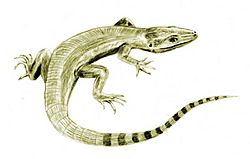Archaeothyris facts for kids
Quick facts for kids ArchaeothyrisTemporal range: Upper Carboniferous
|
|
|---|---|
 |
|
| Archaeothyris | |
| Scientific classification | |
| Kingdom: | |
| Phylum: | |
| Superclass: | |
| Class: | |
| Order: | |
| Genus: |
Archaeothyris
|
| Species: |
A. florensis
|
| Binomial name | |
| Archaeothyris florensis Reisz, 1972
|
|
Archaeothyris was the earliest definite synapsid. It lived in the late Carboniferous period, 306 million years ago.
It was found in Nova Scotia, at the same locality as Hylonomus, and Petrolacosaurus, which are similar to Archaeothyris, but probably sauropsids.
Protoclepsydrops is slightly older, but its status as a synapsid is unclear as the remains are more fragmentary.
Systematics
Archaeothyris belonged to a group of early pelycosaurs that evolved early in the Pennsylvanian. It is thus seen as the precursor of all synapsids (which include mammals).
Appearance and lifestyle
Unlike the early sauropsids, Hylonomus and its kin, Archaeothyris was relatively large, measuring 50 centimetres (20 in) head to tail. It was also more advanced than the early sauropsids (~reptiles), with strong jaws that could open wider than those of the sauropsids. Its sharp teeth were all of the same shape, and it had a pair of enlarged canines, suggesting that it was a carnivore.
Archaeothyris lived in what is now Nova Scotia, about 306 million years ago in the Carboniferous Period (Pennsylvanian). Nova Scotia at this time was a swamp, similar to today's Everglades in Florida. The 'trees' (actually giant clubmosses) were very tall. Some, such as Lepidodendron, were up to 50 metres (164 feet) tall. Archaeothyris and the other early amniotes lived on the forest floor.
Images for kids
See also
 In Spanish: Archaeothyris para niños
In Spanish: Archaeothyris para niños

